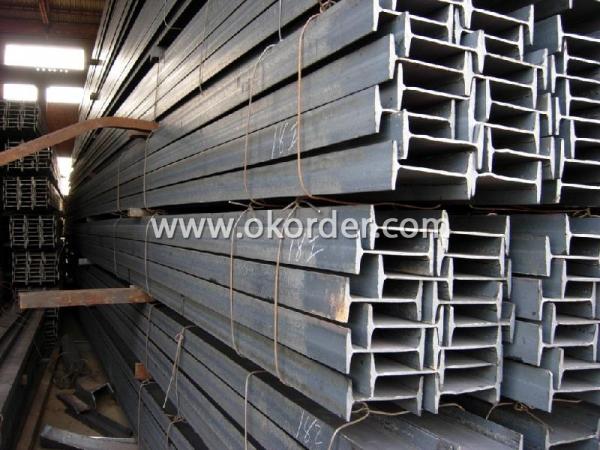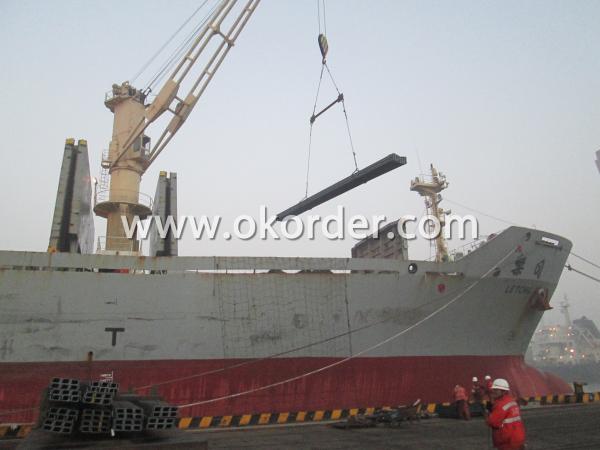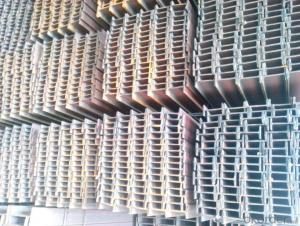EN Standard Hot Rolled Steel I Beams IPE/IPEAA
- Loading Port:
- Tianjin
- Payment Terms:
- TT OR LC
- Min Order Qty:
- 25 m.t.
- Supply Capability:
- 200000 m.t./month
OKorder Service Pledge
OKorder Financial Service
You Might Also Like
Specifications of EN Standard Hot Rolled Steel I Beams IPE/IPEAA
1. Product name: IPE/IPEAA Beam Steel
2. Standard: EN10025, GB Standard, ASTM, JIS etc.
3. Grade: Q235B, A36, S235JR, Q345, SS400 or other equivalent.
4. Length: 5.8M, 6M, 9M, 10M, 12M or as your requirements

Section | Standard Sectional Dimensions(mm) | ||||
h | b | s | t | Mass Kg/m | |
IPE80 | 80 | 46 | 3.80 | 5.20 | 6.00 |
IPE100 | 100 | 55 | 4.10 | 5.70 | 8.10 |
IPE120 | 120 | 64 | 4.80 | 6.30 | 10.40 |
IPE140 | 140 | 73 | 4.70 | 6.90 | 12.90 |
IPE160 | 160 | 82 | 5.00 | 7.40 | 15.80 |
IPE180 | 180 | 91 | 5.30 | 8.00 | 18.80 |
IPE200 | 200 | 100 | 5.60 | 8.50 | 22.40 |
IPE220 | 220 | 110 | 5.90 | 9.20 | 26.20 |
IPE240 | 240 | 120 | 6.20 | 9.80 | 30.70 |
IPE270 | 270 | 135 | 6.60 | 10.20 | 36.10 |
IPEAA80 | 80 | 46 | 3.20 | 4.20 | 4.95 |
IPEAA100 | 100 | 55 | 3.60 | 4.50 | 6.72 |
IPEAA120 | 120 | 64 | 3.80 | 4.80 | 8.36 |
IPEAA140 | 140 | 73 | 3.80 | 5.20 | 10.05 |
IPEAA160 | 160 | 82 | 4.00 | 5.60 | 12.31 |
IPEAA180 | 180 | 91 | 4.30 | 6.50 | 15.40 |
IPEAA200 | 200 | 100 | 4.50 | 6.70 | 17.95 |

Applications of EN Standard Hot Rolled Steel I Beams IPE/IPEAA
IPE/IPEAA Beam Steel are widely used in various construction structures, bridges, autos, brackets, mechanisms and so on.
Packing & Delivery Terms of IPE/IPEAA Beam Steel
1. Package: All the IPE/IPEAA Beam Steel will be tired by wire rod in bundles
2. Bundle weight: not more than 3.5MT for bulk vessel; less than 3 MT for container load
3. Marks:
Color marking: There will be color marking on both end of the bundle for the cargo delivered by bulk vessel. That makes it easily to distinguish at the destination port.
Tag mark: there will be tag mark tied up on the bundles. The information usually including supplier logo and name, product name, made in China, shipping marks and other information request by the customer.
If loading by container the marking is not needed, but we will prepare it as customer request.
4. Shipment: In containers or in bulk cargo


5. Delivery time: All the IPE/IPEAA Beam Steel will be at the port of the shipment within 45 days after receiving the L/C at sight ot the advance pyment.
6. Payment: L/C at sight; 30% advance payment before production, 70% before shipment by T/T, etc.
Production flow of EN Standard Hot Rolled Steel I Beams IPE/IPEAA
Material prepare (billet) —heat up—rough rolling—precision rolling—cooling—packing—storage and transportation
- Q:Can steel I-beams be used for multi-story buildings?
- Yes, steel I-beams can definitely be used for multi-story buildings. Steel I-beams are commonly used in construction due to their high strength-to-weight ratio, which makes them ideal for supporting heavy loads over long spans. They provide structural integrity and stability to buildings, especially in multi-story structures where the weight and forces are significantly higher. Steel I-beams are also versatile as they can be easily fabricated to meet specific design requirements, making them suitable for a variety of building types and sizes. Additionally, steel is a durable and non-combustible material, providing excellent fire resistance and ensuring the safety of occupants in multi-story buildings.
- Q:What is the difference between I-beam and H steel?
- The H steel wing plate is equal thickness, and the size of the H steel can not be used as lifting track, otherwise there will be willing rail, rail and other phenomena, therefore, I-beam can not be replaced by H steel. The misuse of this kind of work has been firmly corrected,. General I-beam is a kind of rail steel, and H steel is mainly structural steel, the use of different, there are essential differences.
- Q:What is the average lifespan of a steel I-beam?
- The average lifespan of a steel I-beam can vary depending on a range of factors such as the quality of the steel used, the environment in which it is installed, and the level of maintenance it receives. Generally, a well-maintained steel I-beam can last for several decades or even longer. With regular inspections, proper cleaning, and adequate protection against corrosion, a steel I-beam can have a lifespan of 50 years or more. However, in harsh environments with high levels of moisture, salt, or chemical exposure, the lifespan may be significantly shorter. It is important to consult with structural engineers and follow manufacturer guidelines to ensure the longevity of the steel I-beam.
- Q:Are there any building codes or regulations specific to steel I-beams?
- Steel I-beams are subject to specific building codes and regulations to ensure their safe and structurally sound design, manufacture, and installation. These regulations vary between countries and regions. In the United States, the American Institute of Steel Construction (AISC) is responsible for providing the primary code for structural steel. Known as the Specification for Structural Steel Buildings, this code outlines requirements for designing steel structures, including I-beams. It covers various aspects such as load calculations, material properties, connection design, and construction tolerances. Furthermore, local building codes and regulations established by state or municipal authorities may impose additional requirements or modifications specific to steel I-beams. These codes may address concerns like fire protection, seismic design, wind loads, and site-specific conditions. Compliance with these codes and regulations is crucial for architects, structural engineers, and construction professionals involved in designing and constructing buildings with steel I-beams. Adhering to these standards ensures the building's structural integrity and safety while providing a consistent framework for the industry to follow.
- Q:What are the different factors that affect the strength of steel I-beams?
- The strength of steel I-beams is influenced by several factors, including material composition, cross-sectional shape, moment of inertia, length and unsupported span, load distribution, temperature, manufacturing and fabrication processes, and corrosion and environmental factors. 1. Material composition: The strength of the I-beam is greatly influenced by the type of steel used and its chemical composition. Higher carbon content generally results in increased strength, while other alloying elements like manganese, silicon, and nickel can also impact strength properties. 2. Cross-sectional shape: The shape of the I-beam's cross-section plays a significant role in determining its strength. The overall strength of the beam is influenced by factors such as flange width, flange thickness, and web thickness. Generally, wider flanges and thicker web sections contribute to greater strength. 3. Moment of inertia: The beam's strength is affected by its moment of inertia, which measures its resistance to changes in rotation. A higher moment of inertia indicates a greater resistance to bending, thereby increasing the beam's strength. 4. Length and unsupported span: The strength of the I-beam can be impacted by its length and the unsupported span it needs to cover. Longer beams and larger unsupported spans may require additional support or reinforcement to maintain their strength. 5. Load distribution: The distribution of load along the beam's length influences its strength. Concentrated loads and point loads exert more stress on specific areas, potentially leading to localized failure. Uniformly distributed loads are generally more favorable for maintaining the beam's strength. 6. Temperature: Changes in temperature can affect the strength of steel. High temperatures can cause thermal expansion and softening, reducing strength. Conversely, extremely low temperatures can make the steel brittle and more prone to fracture. 7. Manufacturing and fabrication processes: The strength of the I-beam can be influenced by the quality of the manufacturing and fabrication processes employed. Proper welding, heat treatment, and post-processing can enhance the structural integrity and strength of the beam. 8. Corrosion and environmental factors: The presence of corrosive agents like moisture or chemicals can weaken the steel over time. To preserve the beam's strength, it is essential to apply proper protective coatings and regularly maintain it. Considering these factors is crucial when designing and selecting steel I-beams for various applications to ensure optimal strength and structural integrity.
- Q:Can steel I-beams be used for schools and universities?
- Yes, steel I-beams can be used for schools and universities. Steel I-beams are commonly used in the construction industry due to their strength, durability, and versatility. They have excellent load-bearing capacity, making them suitable for supporting the weight of large structures like schools and universities. Additionally, steel I-beams can be easily fabricated and installed, allowing for efficient construction processes. Moreover, steel is a non-combustible material, which is important for ensuring the safety of the building occupants. Overall, steel I-beams are a popular choice for constructing schools and universities due to their structural integrity, cost-effectiveness, and ability to meet the necessary building codes and regulations.
- Q:What are the potential risks of using steel I-beams in construction?
- One potential risk of using steel I-beams in construction is the susceptibility to corrosion. If not properly protected or maintained, steel beams can rust over time, which can weaken their structural integrity. Additionally, steel beams are heavy and require specialized equipment for installation, posing risks to workers' safety if not handled properly. Another potential risk is the high thermal conductivity of steel, which can result in heat loss or gain, affecting the energy efficiency of buildings. Finally, steel I-beams can be expensive compared to other construction materials, which may impact the overall project cost.
- Q:Can steel I-beams be used in energy-efficient building designs?
- Energy-efficient building designs can incorporate steel I-beams as they offer numerous benefits. Firstly, steel I-beams possess a high strength-to-weight ratio, allowing for the construction of lighter and slender structural elements. This means that less material is required, resulting in a reduced overall weight of the building. Consequently, less energy is needed during construction, transportation, and erection, leading to lower embodied energy. Additionally, steel I-beams can be manufactured with great precision, ensuring accurate dimensions and minimizing waste during construction. Furthermore, the use of prefabricated steel components accelerates the construction process, reducing energy consumption related to on-site labor and equipment. In terms of energy efficiency during the operational phase, steel I-beams contribute to the thermal performance of a building. Steel has low thermal conductivity, meaning it is a poor conductor of heat. Consequently, it enables better insulation and reduces heat transfer through the building envelope, resulting in decreased heating and cooling loads. Furthermore, steel can be combined with insulation and thermal breaks to create a more energy-efficient building envelope. Moreover, steel is highly durable and resistant to pests, rot, and decay. This durability minimizes the need for frequent maintenance and replacement, thereby conserving energy and resources in the long run. In conclusion, due to their high strength-to-weight ratio, precision manufacturing, thermal performance, durability, and potential for prefabrication, steel I-beams can effectively contribute to energy-efficient building designs.
- Q:Are there any limitations on the length of steel I-beams?
- The length of steel I-beams is subject to limitations. These limitations stem from the manufacturing process, transportation restrictions, and the structural needs of the specific application. When it comes to manufacturing, the length of steel I-beams is primarily restricted by the size of the equipment employed in their production. Steel mills utilize machinery designed for shaping steel into different forms, including I-beams. These machines have their own maximum length limitations. Transportation constraints also contribute to the limitation of steel I-beam lengths. Longer beams may pose difficulties during transportation due to weight restrictions, road or bridge limitations, or logistical obstacles. Compliance with local regulations and transportation capabilities necessitates consideration of the beams' size and weight. Additionally, the structural requirements of the application influence the length of steel I-beams. Longer beams may require additional support, such as intermediate columns or bracing, to ensure structural stability. The beam's strength and rigidity must be evaluated in relation to the span it is intended to cover. In conclusion, although there are no universal fixed limits on the length of steel I-beams, their dimensions are generally determined by the capabilities of the manufacturing process, transportation restrictions, and the structural demands of the particular application.
- Q:What are the different types of steel connections used for composite I-beams?
- There are several types of steel connections commonly used for composite I-beams, which are engineered to combine the strengths of both steel and concrete in structural applications. These connections ensure the effective transfer of forces between the steel beam and the concrete slab to create a unified and efficient load-bearing system. One type of steel connection used for composite I-beams is the shear stud connection. Shear studs are short, steel bars that are welded to the top flange of the steel beam prior to pouring the concrete slab. The studs act as shear connectors, effectively transferring the shear forces between the steel beam and the concrete slab. This type of connection enhances the composite behavior of the beam by allowing the concrete slab to act as a compression member, increasing the overall strength and rigidity of the system. Another common type of connection is the bolted connection. Bolted connections are typically used in composite I-beams where the steel beam is connected to other steel members or accessories, such as column flanges, bracing, or other beams. These connections involve the use of high-strength bolts and nuts, which are tightened to a specific torque to ensure proper load transfer and structural integrity. Bolted connections provide flexibility in terms of assembly, disassembly, and modification of the structure. Welded connections are also utilized in composite I-beams, particularly in cases where the steel beam needs to be connected to other steel elements. Welding involves the fusion of the steel materials using heat, creating a strong and permanent connection. Welded connections offer high strength and durability, making them suitable for applications where significant loads and forces are involved. Moreover, moment connections are used in composite I-beams to transfer moments or rotational forces between the steel beam and the concrete slab. These connections are often achieved through a combination of shear studs, bolts, and welding. Moment connections enhance the overall behavior of the composite system by allowing it to resist bending moments and provide stability to the structure. In summary, the different types of steel connections used for composite I-beams include shear stud connections, bolted connections, welded connections, and moment connections. Each type of connection serves a specific purpose in ensuring the effective transfer of forces and enhancing the performance of the composite beam system. The selection of the appropriate connection depends on the specific design requirements, loads, and structural considerations of the project.
1. Manufacturer Overview |
|
|---|---|
| Location | |
| Year Established | |
| Annual Output Value | |
| Main Markets | |
| Company Certifications | |
2. Manufacturer Certificates |
|
|---|---|
| a) Certification Name | |
| Range | |
| Reference | |
| Validity Period | |
3. Manufacturer Capability |
|
|---|---|
| a)Trade Capacity | |
| Nearest Port | |
| Export Percentage | |
| No.of Employees in Trade Department | |
| Language Spoken: | |
| b)Factory Information | |
| Factory Size: | |
| No. of Production Lines | |
| Contract Manufacturing | |
| Product Price Range | |
Send your message to us
EN Standard Hot Rolled Steel I Beams IPE/IPEAA
- Loading Port:
- Tianjin
- Payment Terms:
- TT OR LC
- Min Order Qty:
- 25 m.t.
- Supply Capability:
- 200000 m.t./month
OKorder Service Pledge
OKorder Financial Service
Similar products
New products
Hot products
Related keywords
































